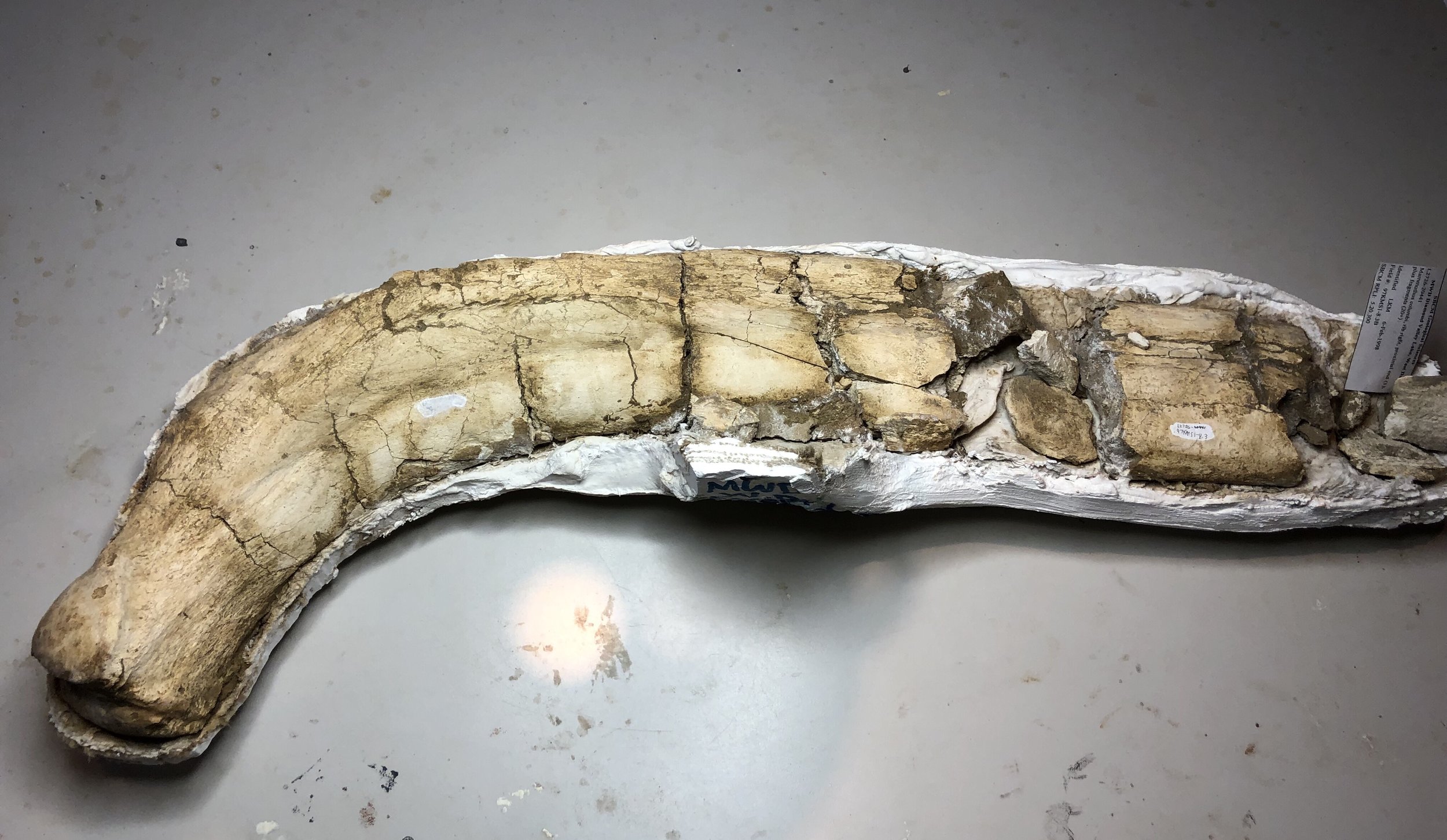 Organisms don't exist in a vacuum. The whole concept of an ecosystem emphasizes the interactions between an organism and its environment, including with other organisms. A large organism like a mammoth can have wide-ranging effects on numerous other organisms, even after its death.The specimen shown above is a partial Colombian mammoth rib from Diamond Valley Lake, currently being prepared by volunteer Tim Dooley. We have a large number of rib fragments such as this one, and at first glance they all look pretty much the same. But under close examination they often tell unique stories.After removing glue used to stabilize the specimen in the field, we realized this bone has a number of small, circular pits covering its surface:
Organisms don't exist in a vacuum. The whole concept of an ecosystem emphasizes the interactions between an organism and its environment, including with other organisms. A large organism like a mammoth can have wide-ranging effects on numerous other organisms, even after its death.The specimen shown above is a partial Colombian mammoth rib from Diamond Valley Lake, currently being prepared by volunteer Tim Dooley. We have a large number of rib fragments such as this one, and at first glance they all look pretty much the same. But under close examination they often tell unique stories.After removing glue used to stabilize the specimen in the field, we realized this bone has a number of small, circular pits covering its surface:
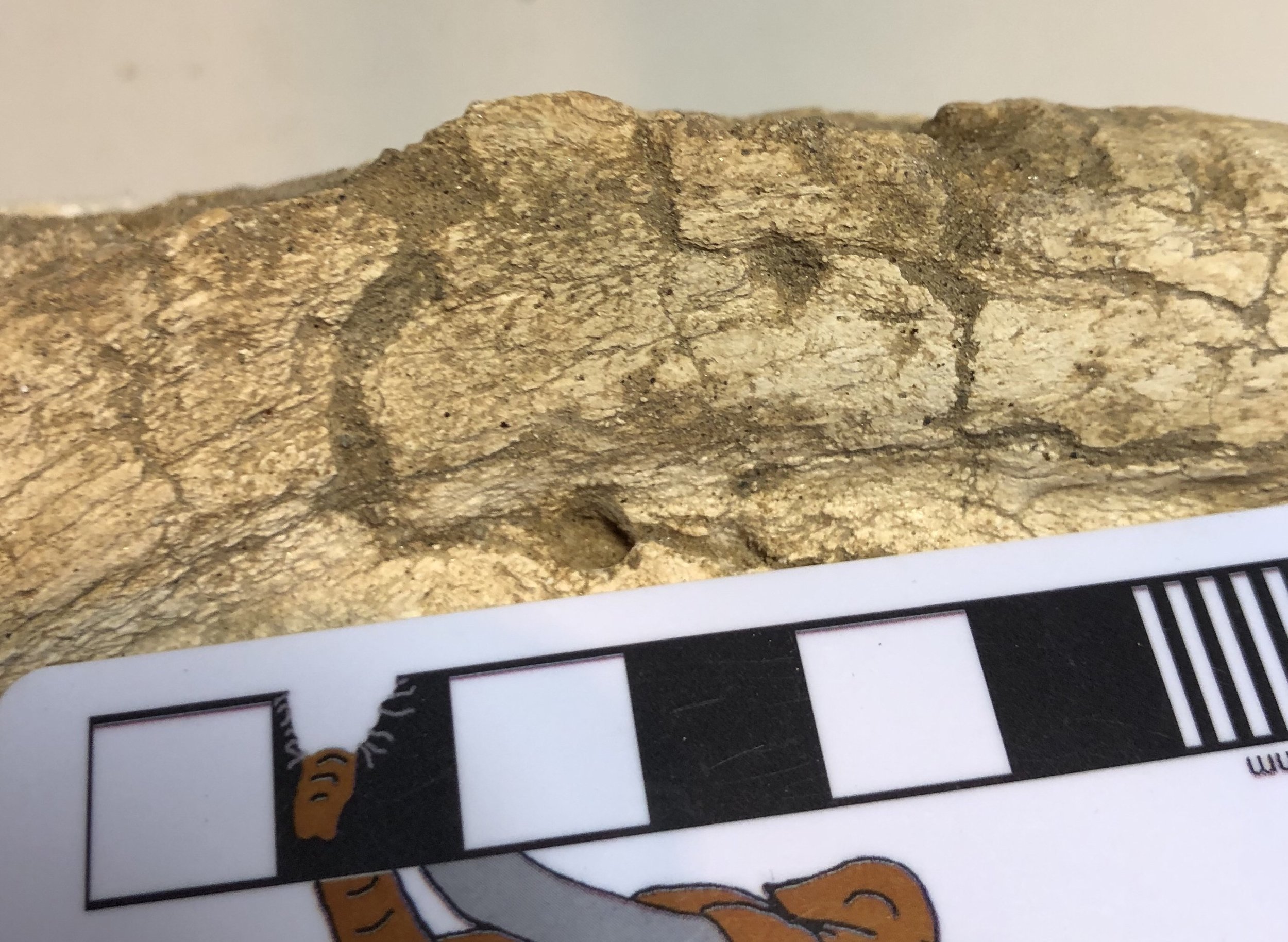
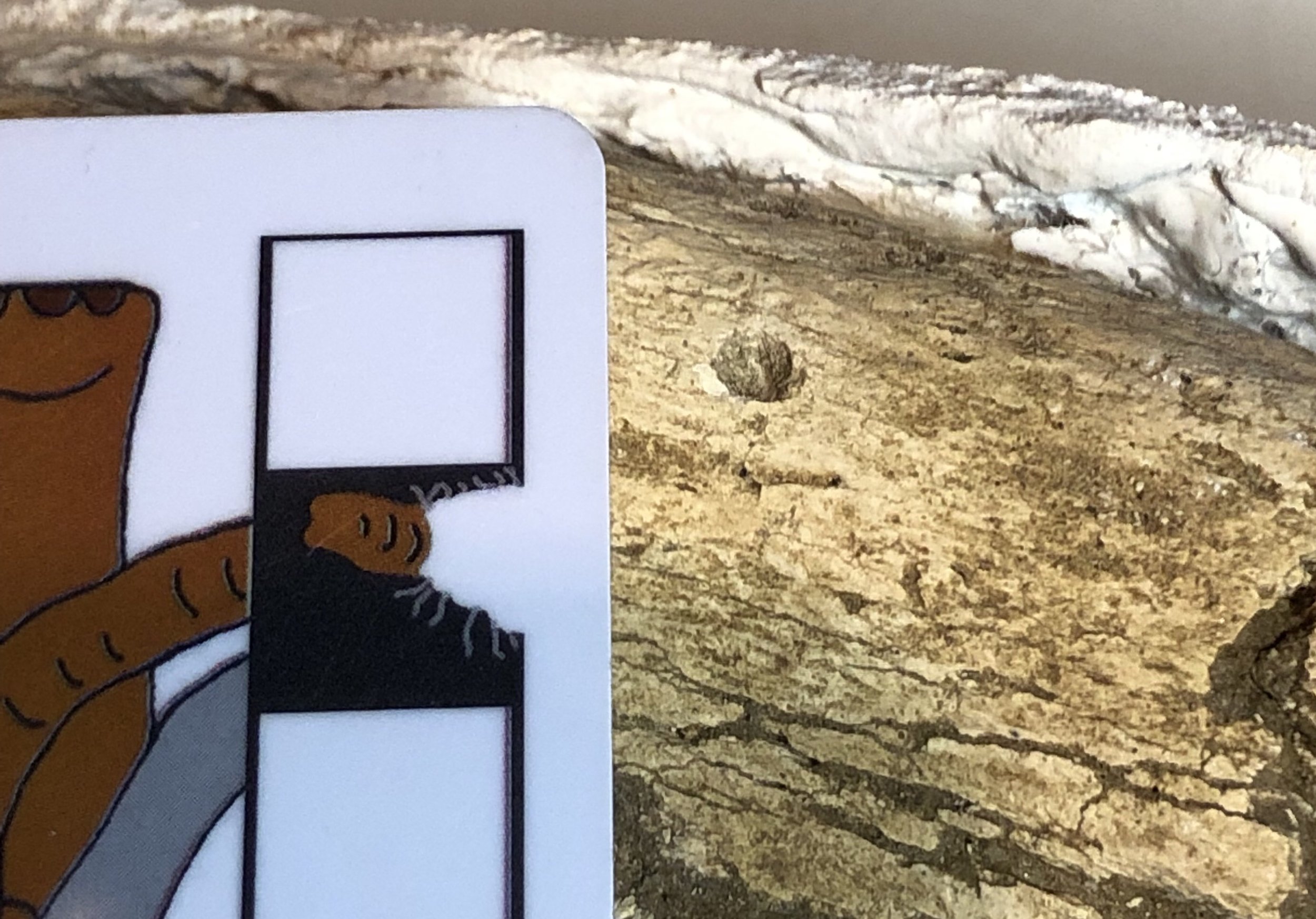 There are also some rough, pitted areas:
There are also some rough, pitted areas: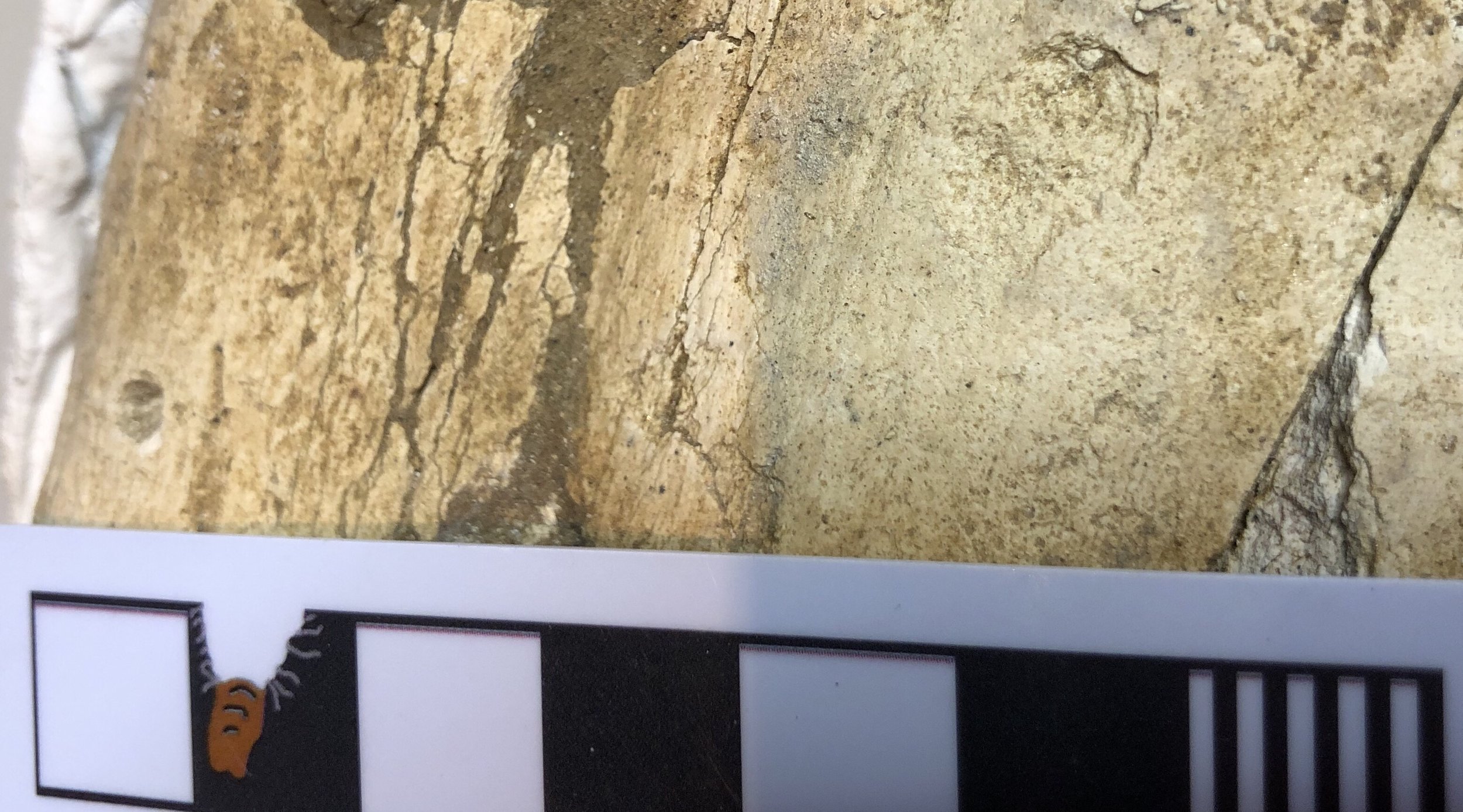 While I'm not 100% sure, I believe these are traces made by scavenging insects or other invertebrates, especially the rough patches in the last photo. I'm a little less certain of the circular holes. They are reminiscent of vertebrate bite marks, but they aren't paired and are tiny (all are less than 5 mm in diameter), so I think some sort of burrowing or bone-eating invertebrate is more likely.Marks such as these are quite common on DVL bones, and may eventually give us some insight into the invertebrate fauna from the valley, which left us almost no body fossils.
While I'm not 100% sure, I believe these are traces made by scavenging insects or other invertebrates, especially the rough patches in the last photo. I'm a little less certain of the circular holes. They are reminiscent of vertebrate bite marks, but they aren't paired and are tiny (all are less than 5 mm in diameter), so I think some sort of burrowing or bone-eating invertebrate is more likely.Marks such as these are quite common on DVL bones, and may eventually give us some insight into the invertebrate fauna from the valley, which left us almost no body fossils.
Fossil Friday - mammoth molar
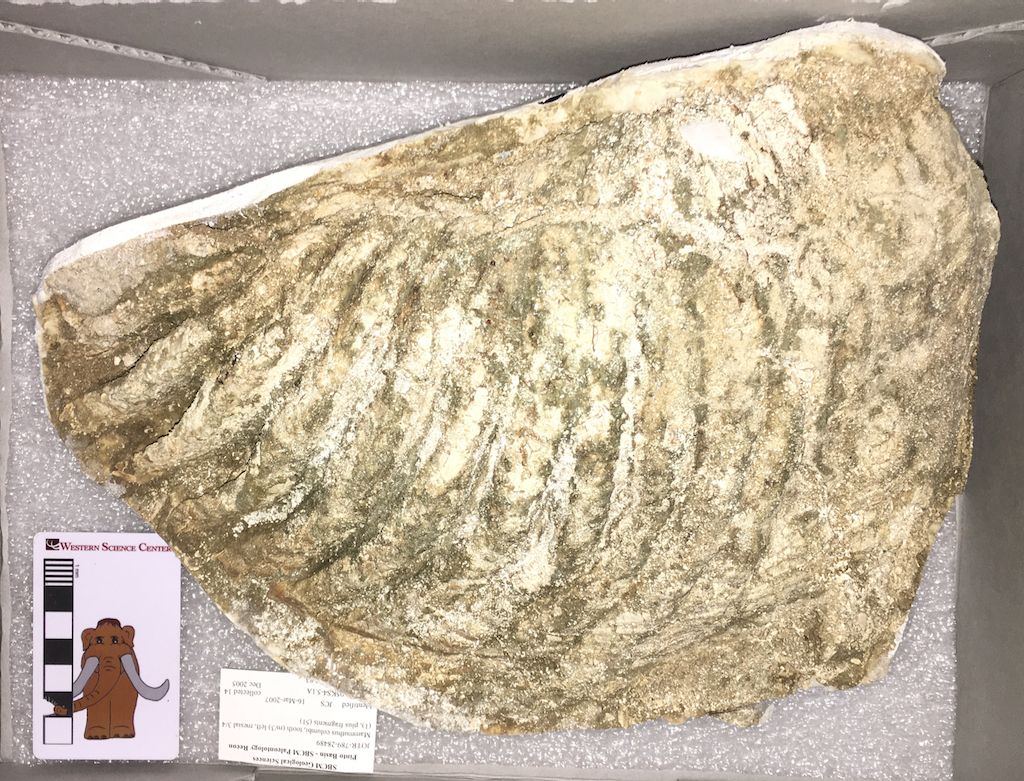 Today's Fossil Friday specimen comes from a location we've never before featured on this blog, Joshua Tree National Park.Joshua Tree is most famous for its eponymous trees and its spectacular granite formations, but there are also significant Pleistocene fossil deposits within the park. Over a period of several years Kathleen Springer and Eric Scott (then at the San Bernardino County Museum) collected some of these remains under a NPS permit. Earlier this week Joshua Tree designated Western Science Center as the repository for that collection and transferred the specimens here.The Joshua Tree fauna is an contrast with other Southern California sites such as Diamond Valley Lake in that, like today, during the Pleistocene it was more mountainous and more arid than the inland valleys. While the fossils from Joshua Tree are almost all fragmentary and poorly preserved, studying the fauna from this site will help give us a more complete understanding of how California ecosystems worked during the Pleistocene.The particular fossil shown here is a Columbian mammoth lower left third molar, one of several mammoth remains in the collection. Mammoths seem to be one taxon that had a great deal of ecological flexibility, as they are found in almost every imaginable Pleistocene deposit.Thanks to Melanie Spoo of Joshua Tree National Park and Vincent Santucci of the National Park Service for arranging the move of the Joshua Tree fossils to WSC.
Today's Fossil Friday specimen comes from a location we've never before featured on this blog, Joshua Tree National Park.Joshua Tree is most famous for its eponymous trees and its spectacular granite formations, but there are also significant Pleistocene fossil deposits within the park. Over a period of several years Kathleen Springer and Eric Scott (then at the San Bernardino County Museum) collected some of these remains under a NPS permit. Earlier this week Joshua Tree designated Western Science Center as the repository for that collection and transferred the specimens here.The Joshua Tree fauna is an contrast with other Southern California sites such as Diamond Valley Lake in that, like today, during the Pleistocene it was more mountainous and more arid than the inland valleys. While the fossils from Joshua Tree are almost all fragmentary and poorly preserved, studying the fauna from this site will help give us a more complete understanding of how California ecosystems worked during the Pleistocene.The particular fossil shown here is a Columbian mammoth lower left third molar, one of several mammoth remains in the collection. Mammoths seem to be one taxon that had a great deal of ecological flexibility, as they are found in almost every imaginable Pleistocene deposit.Thanks to Melanie Spoo of Joshua Tree National Park and Vincent Santucci of the National Park Service for arranging the move of the Joshua Tree fossils to WSC.
Fossil Friday - mammoth tooth
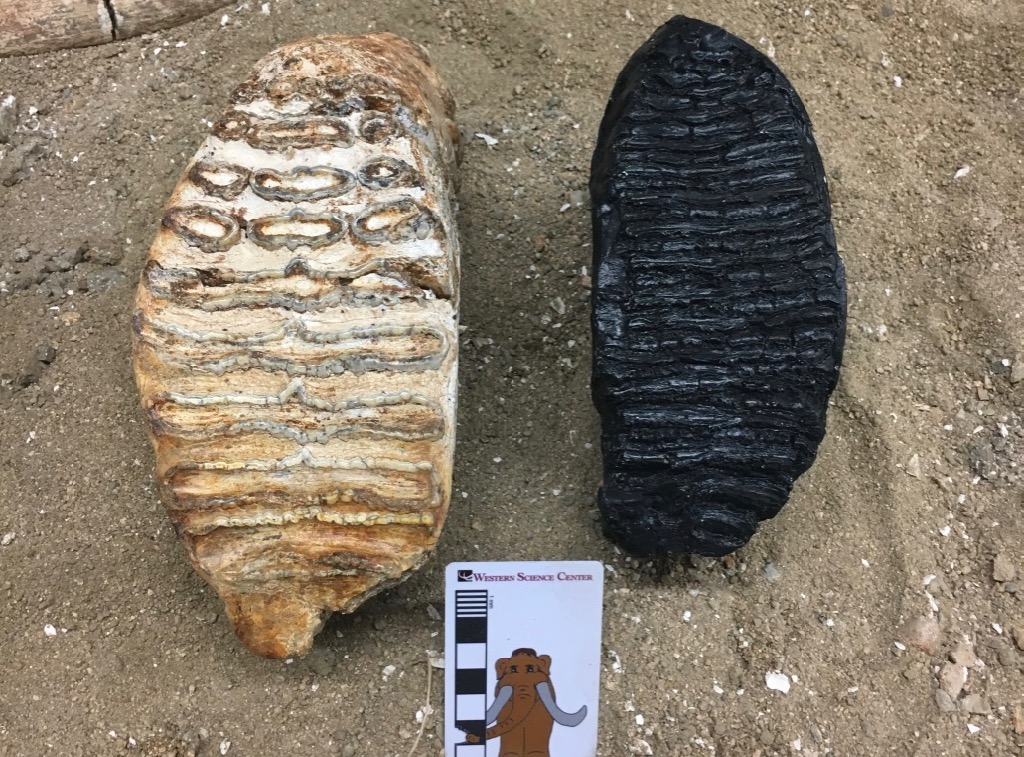 Tomorrow is the Western Science Center's annual fundraiser, Science Under the Stars. That has our entire staff, including me, wrapped up in preparations for 500 guests and a massive benefit auction, so Fossil Friday will necessarily be brief.Above on the left is a partial molar from a Columbian mammoth, Mammuthus columbi, from Pleistocene deposits near Murrieta in Riverside County. As massive as the tooth is, it's incomplete, with the anterior part of the tooth having already worn away. Mammoth teeth (in fact, all the elephants) have enamel arranged in transverse plates that wear to enamel loops on the occlusal surface.The tooth on the right is a cast of a wooly mammoth (M. primigenius) from Alaska. While it's a little difficult to see on the black tooth, the enamel plates on the wooly mammoth are thinner and more numerous than on the Columbian mammoth. This general rule is often used to distinguish between the two species, but as so often seems to be the case, proboscideans are not good at following rules! There is considerable overlap in this character ("lamellar frequency") between Columbian and wooly mammoths. Moreover, it appears that the two species were regularly interbreeding where their ranges overlapped (the apparent hybrids were originally given a different species name, M. jeffersonii). And recent genetic evidence calls into question whether Columbian and wooly mammoths were in fact just different morphs of a single, highly variable species.
Tomorrow is the Western Science Center's annual fundraiser, Science Under the Stars. That has our entire staff, including me, wrapped up in preparations for 500 guests and a massive benefit auction, so Fossil Friday will necessarily be brief.Above on the left is a partial molar from a Columbian mammoth, Mammuthus columbi, from Pleistocene deposits near Murrieta in Riverside County. As massive as the tooth is, it's incomplete, with the anterior part of the tooth having already worn away. Mammoth teeth (in fact, all the elephants) have enamel arranged in transverse plates that wear to enamel loops on the occlusal surface.The tooth on the right is a cast of a wooly mammoth (M. primigenius) from Alaska. While it's a little difficult to see on the black tooth, the enamel plates on the wooly mammoth are thinner and more numerous than on the Columbian mammoth. This general rule is often used to distinguish between the two species, but as so often seems to be the case, proboscideans are not good at following rules! There is considerable overlap in this character ("lamellar frequency") between Columbian and wooly mammoths. Moreover, it appears that the two species were regularly interbreeding where their ranges overlapped (the apparent hybrids were originally given a different species name, M. jeffersonii). And recent genetic evidence calls into question whether Columbian and wooly mammoths were in fact just different morphs of a single, highly variable species.
Fossil Friday - mammoth tusk
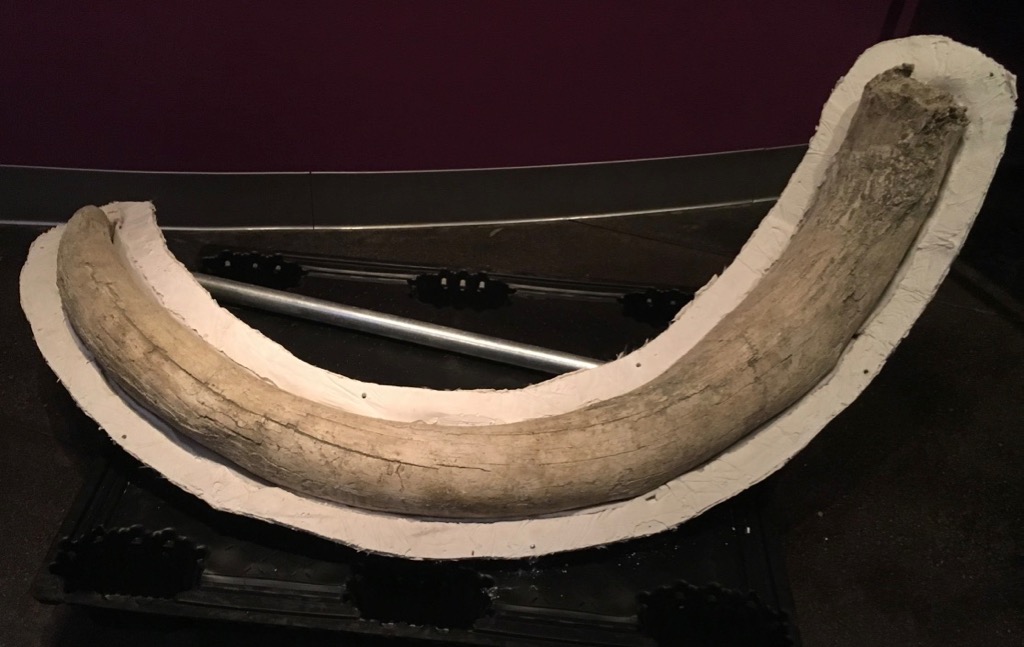 I missed last Fossil Friday while I was attending the Society of Vertebrate Paleontology in Calgary, which included posters on Diamond Valley Lake mastodon tusks and the Valley of the Mastodons Symposium and Exhibit. But I'm now back in Hemet, and ready for some more Fossil Friday posts!A few months ago I posted about a Columbian mammoth lower jaw from Merced County, collected by PaleoResources during a Caltrans road project. There was actually quite a bit of material recovered during this project, and we're currently in the process of integrating it into the WSC collections. One of the other large pieces is the tusk shown above.This is a typical left tusk from a mammoth, with strong curvature in multiple planes resulting in an open spiral shape. Mastodon tusks, in contrast, tend to be thicker for a given length (at least in males), and curve more strongly in one plane than the other, so the tusk is more of an arc than a spiral. While it's difficult to see from this angle, the tusk shown here has a fairly prominent wear facet at the tip.When PaleoResources dropped off this collection, they indicated that they suspected the mammoth material represented more than one individual, even though there were no duplicate pieces (so that, technically, the minimum number of individuals = 1). I agree with PaleoResources' assessment; I don't see any way such a large tusk could have come from a mammoth as young as the one represented by the lower jaw in the same deposit.This tusk, along with the juvenile lower jaw and an associated mammoth pelvis, are currently on display at the Western Science Center.
I missed last Fossil Friday while I was attending the Society of Vertebrate Paleontology in Calgary, which included posters on Diamond Valley Lake mastodon tusks and the Valley of the Mastodons Symposium and Exhibit. But I'm now back in Hemet, and ready for some more Fossil Friday posts!A few months ago I posted about a Columbian mammoth lower jaw from Merced County, collected by PaleoResources during a Caltrans road project. There was actually quite a bit of material recovered during this project, and we're currently in the process of integrating it into the WSC collections. One of the other large pieces is the tusk shown above.This is a typical left tusk from a mammoth, with strong curvature in multiple planes resulting in an open spiral shape. Mastodon tusks, in contrast, tend to be thicker for a given length (at least in males), and curve more strongly in one plane than the other, so the tusk is more of an arc than a spiral. While it's difficult to see from this angle, the tusk shown here has a fairly prominent wear facet at the tip.When PaleoResources dropped off this collection, they indicated that they suspected the mammoth material represented more than one individual, even though there were no duplicate pieces (so that, technically, the minimum number of individuals = 1). I agree with PaleoResources' assessment; I don't see any way such a large tusk could have come from a mammoth as young as the one represented by the lower jaw in the same deposit.This tusk, along with the juvenile lower jaw and an associated mammoth pelvis, are currently on display at the Western Science Center.
Fossil Friday - mammoth jaw
 Most of the current collections growth at the Western Science Center comes in the form of mitigation projects, fossils and artifacts that are recovered during various construction projects. Most of the projects that have come to us are from Riverside County, but we're increasingly starting to bring in material from other areas.Earlier this week we received several Colombian mammoth bones from a Caltrans road project in Merced County, California. The fossils were recovered and beautifully prepared by PaleoResource Consultants. While it appears that all the bones are mammoth, they do not appear to all come from one individual.One of the best-preserved elements is a lower jaw, shown above in dorsal view. The tooth in place is quite small, and is apparently either the fourth premolar or the first molar (I'm leaning toward the 4th premolar, but I need to examine it further to be sure). That makes this a very young animal; if the tooth is the 4th premolar it was probably only about 3 years old, and if it's the 1st molar it would still only be about 13 years old. There are going to be lots of things to work on in this small but significant collection.Thanks to Caltrans and PaleoResources Consultants for bring us this exciting specimen, and to Pat Holroyd at the UC Berkeley Museum of Paleontology, who put us in touch with PaleoResources.
Most of the current collections growth at the Western Science Center comes in the form of mitigation projects, fossils and artifacts that are recovered during various construction projects. Most of the projects that have come to us are from Riverside County, but we're increasingly starting to bring in material from other areas.Earlier this week we received several Colombian mammoth bones from a Caltrans road project in Merced County, California. The fossils were recovered and beautifully prepared by PaleoResource Consultants. While it appears that all the bones are mammoth, they do not appear to all come from one individual.One of the best-preserved elements is a lower jaw, shown above in dorsal view. The tooth in place is quite small, and is apparently either the fourth premolar or the first molar (I'm leaning toward the 4th premolar, but I need to examine it further to be sure). That makes this a very young animal; if the tooth is the 4th premolar it was probably only about 3 years old, and if it's the 1st molar it would still only be about 13 years old. There are going to be lots of things to work on in this small but significant collection.Thanks to Caltrans and PaleoResources Consultants for bring us this exciting specimen, and to Pat Holroyd at the UC Berkeley Museum of Paleontology, who put us in touch with PaleoResources.
Fossil Friday - proboscidean ulna
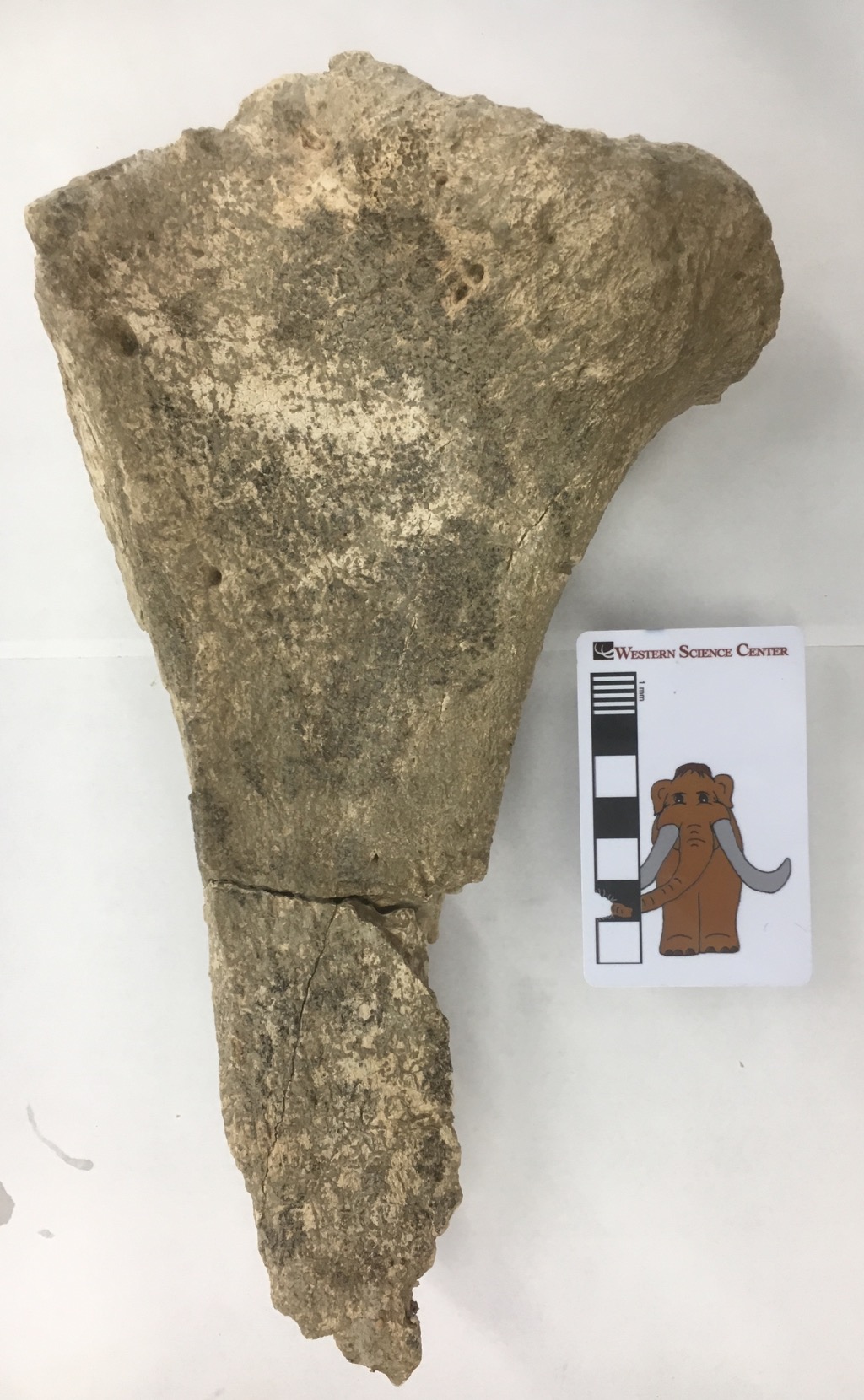 Over the last few weeks we've started pulling a lot of mastodon material from the collections (more on that in a future post). Some of the bones that are turning up are pretty interesting.The large bone fragment shown above is a small part of the proximal end of the right ulna, one of the bones in the forearm. It's shown above in lateral view, and below is looking at the proximal end (part of the articular surface for the elbow):
Over the last few weeks we've started pulling a lot of mastodon material from the collections (more on that in a future post). Some of the bones that are turning up are pretty interesting.The large bone fragment shown above is a small part of the proximal end of the right ulna, one of the bones in the forearm. It's shown above in lateral view, and below is looking at the proximal end (part of the articular surface for the elbow):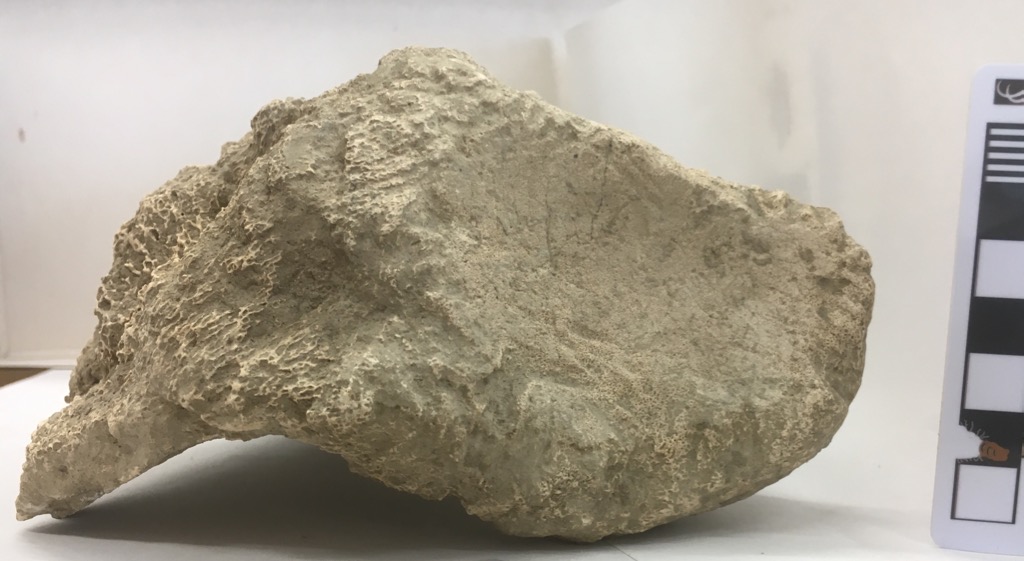 This fragment is labeled at mastodon, but comparing it to the photos in Olsen (1972) it seems to be closer to a mammoth (below). We'll have to examine it more closely and see if there's any associated material to determine for sure which taxon it belongs to
This fragment is labeled at mastodon, but comparing it to the photos in Olsen (1972) it seems to be closer to a mammoth (below). We'll have to examine it more closely and see if there's any associated material to determine for sure which taxon it belongs to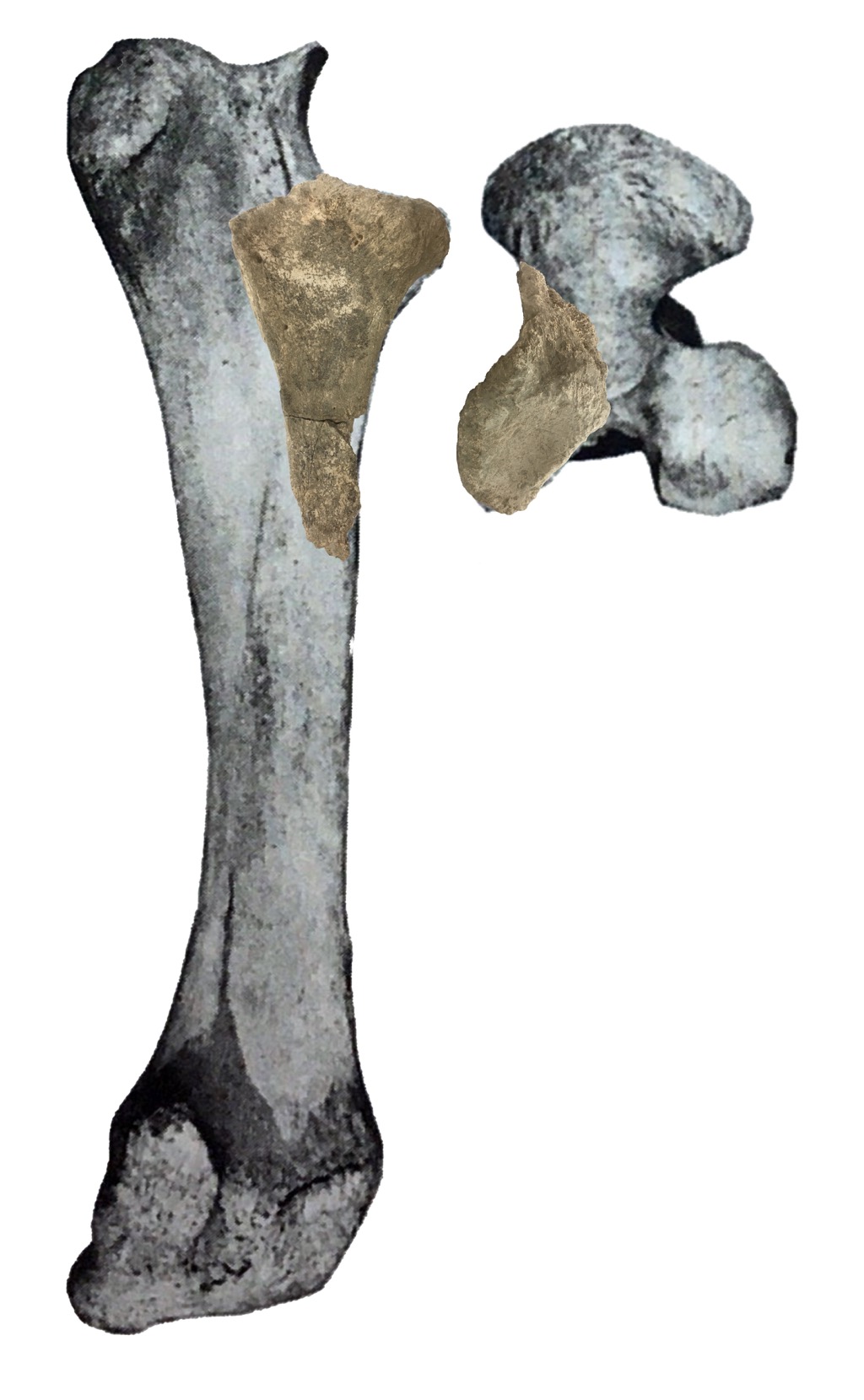 What really caught my attention were details on the edges of the articular surface and a few other places on the bone:
What really caught my attention were details on the edges of the articular surface and a few other places on the bone: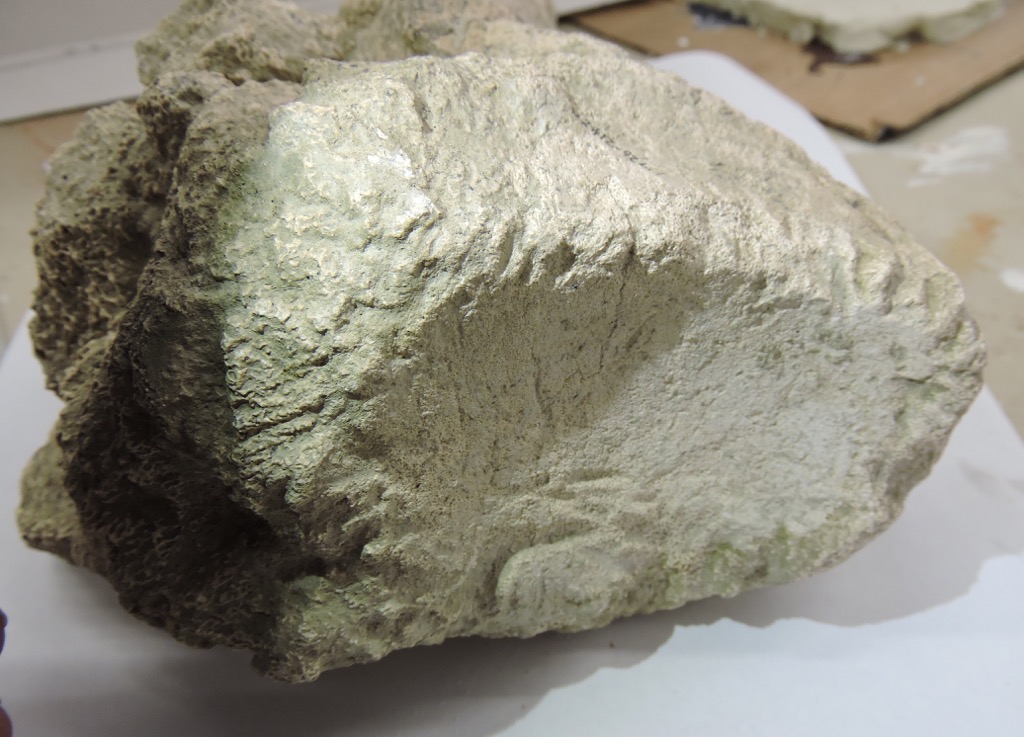
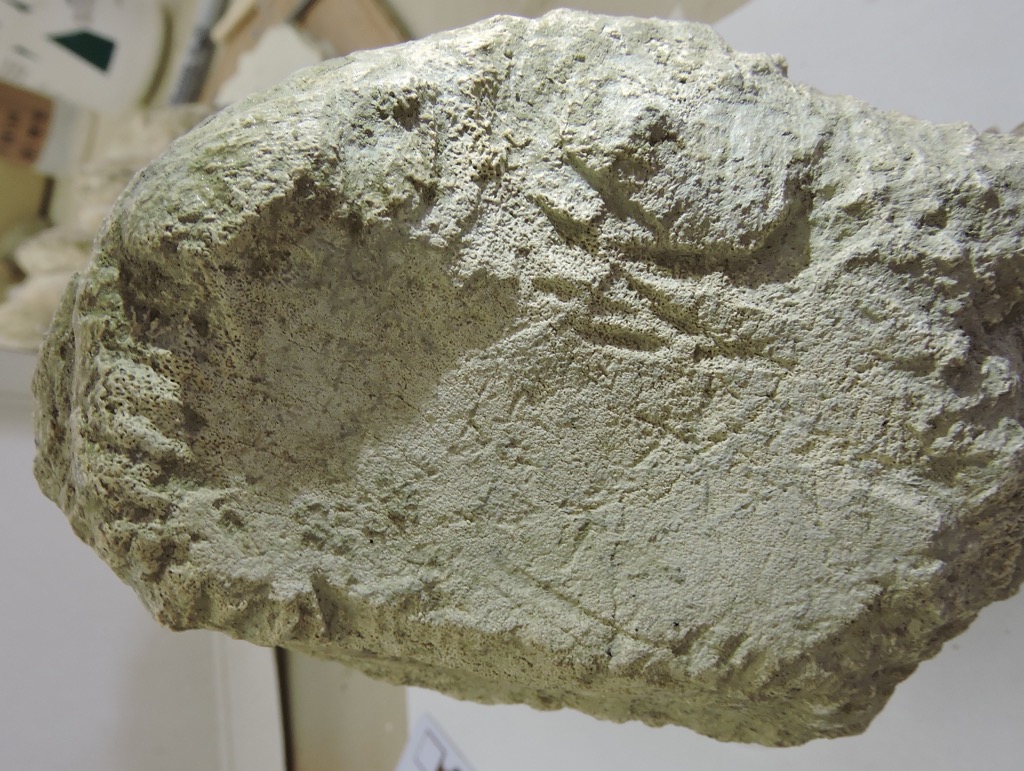
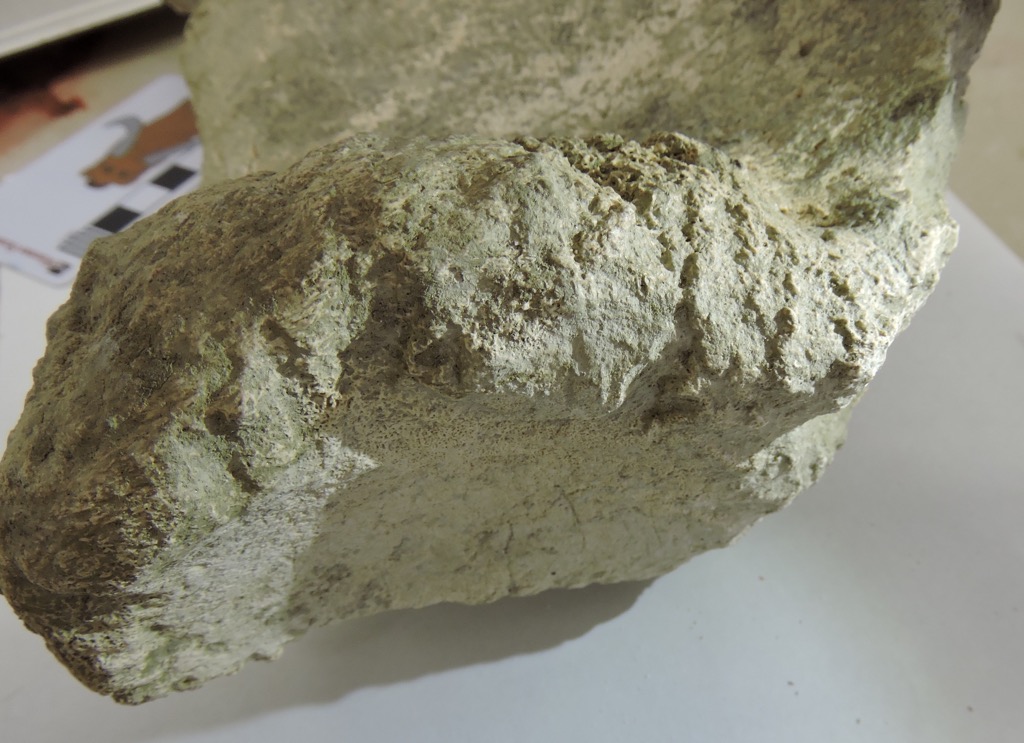 As we're finding with many of the large bones from Diamond Valley Lake, this bone is covered with bite marks from scavengers, in the form of notches cut into the edges of the bone. These are relatively large grooves, consistent in size with something like a coyote or dire wolf, but there are lots of possibilities.
As we're finding with many of the large bones from Diamond Valley Lake, this bone is covered with bite marks from scavengers, in the form of notches cut into the edges of the bone. These are relatively large grooves, consistent in size with something like a coyote or dire wolf, but there are lots of possibilities.
Reference:Olsen, S. J., 1972. Osteology for the Archaeologist No 3: The American mastodon and Wooly mammoth. Papers of the Peabody Museum of Archaeology and Ethnology, Harvard University 58:1-43.
Fossil Friday - possible mastodon bones
 A common theme on this blog is that we can often get a lot of information from very incomplete material. Even so, as a general rule, the more remains we have from a given fossil organism, the more we can say about it. But sometimes we can have multiple bones, and even something as basic as a species identification can be elusive.The small field jacket shown above was collected from the West Dam of Diamond Valley Lake. There are several bones present, all consistent with a single individual. An annotated version is shown below:
A common theme on this blog is that we can often get a lot of information from very incomplete material. Even so, as a general rule, the more remains we have from a given fossil organism, the more we can say about it. But sometimes we can have multiple bones, and even something as basic as a species identification can be elusive.The small field jacket shown above was collected from the West Dam of Diamond Valley Lake. There are several bones present, all consistent with a single individual. An annotated version is shown below: The bone highlighted in blue is the distal end of the left femur. Those in red are ribs, the yellow are thoracic vertebrae, and the purple are unidentified. The size and general shape indicate that these are proboscidean bones, but there are two species from Diamond Valley Lake: the mammoth Mammuthus columbi and the mastodon Mammut americanum. While mastodons are much more common at DVL, numerous mammoth remains were also found. Which species is represented by these bones?Obviously our unidentified bones are not going to be of much help here. Ribs are also notoriously difficult to identify, especially if they're incomplete.The femur is potentially more useful. Femora have lots of distinctive features, and they differ between mammoths and mastodons. The most obvious difference is that mastodon femora are much more robust, while mammoth femora are rather long and slender. Unfortunately, this is difficult to evaluate unless a substantial portion of the femur (roughly half) is preserved. We only have about the distal fourth of the femur, and that is poorly preserved and partially hidden under the other bones. The medial condyle (the large curved knob at the end of the femur) does seem quite large, and this may suggest that a mastodon is more likely, but that's not much to go on.How about the vertebrae? In most vertebral positions mammoth and mastodon vertebrae are quite different. For example, in anterior view the lumbar vertebrae of mastodons have nearly rectangular centra that are wider than tall, while in mammoths they are more heart-shaped and are taller than wide. These vertebrae appear to be posterior thoracic vertebrae. Unfortunately, mammoth and mastodon posterior thoracics are very similar to each other. Mammoths tend to have much longer neural spines on these vertebrae, but the spines are incomplete in this specimen. Mastodons have a slightly taller and differently shaped neural canal, that seems a little more similar to these bones, but it seems this trait is quite variable.The only other hint may be the size. By proboscidean standards, these bones are not particularly large. Even though they're fairly small, they come from a more-or-less adult animal; the condyles are fused to the femur, and the vertebral epiphyses are fused to their centra, both of which indicate an animal that was mostly finished growing. Mammoths were larger than mastodons on average, so that suggests that a mastodon might be more likely (and, of course, mastodons are three times more common at DVL than mammoths).So, which is it? I don't know. I lean toward mastodon, and most of the observations seem to point that way, but that's with a lot of "mays", "seems", "suggests", and other tentative qualifiers. Sometimes, it's hard to say for sure.
The bone highlighted in blue is the distal end of the left femur. Those in red are ribs, the yellow are thoracic vertebrae, and the purple are unidentified. The size and general shape indicate that these are proboscidean bones, but there are two species from Diamond Valley Lake: the mammoth Mammuthus columbi and the mastodon Mammut americanum. While mastodons are much more common at DVL, numerous mammoth remains were also found. Which species is represented by these bones?Obviously our unidentified bones are not going to be of much help here. Ribs are also notoriously difficult to identify, especially if they're incomplete.The femur is potentially more useful. Femora have lots of distinctive features, and they differ between mammoths and mastodons. The most obvious difference is that mastodon femora are much more robust, while mammoth femora are rather long and slender. Unfortunately, this is difficult to evaluate unless a substantial portion of the femur (roughly half) is preserved. We only have about the distal fourth of the femur, and that is poorly preserved and partially hidden under the other bones. The medial condyle (the large curved knob at the end of the femur) does seem quite large, and this may suggest that a mastodon is more likely, but that's not much to go on.How about the vertebrae? In most vertebral positions mammoth and mastodon vertebrae are quite different. For example, in anterior view the lumbar vertebrae of mastodons have nearly rectangular centra that are wider than tall, while in mammoths they are more heart-shaped and are taller than wide. These vertebrae appear to be posterior thoracic vertebrae. Unfortunately, mammoth and mastodon posterior thoracics are very similar to each other. Mammoths tend to have much longer neural spines on these vertebrae, but the spines are incomplete in this specimen. Mastodons have a slightly taller and differently shaped neural canal, that seems a little more similar to these bones, but it seems this trait is quite variable.The only other hint may be the size. By proboscidean standards, these bones are not particularly large. Even though they're fairly small, they come from a more-or-less adult animal; the condyles are fused to the femur, and the vertebral epiphyses are fused to their centra, both of which indicate an animal that was mostly finished growing. Mammoths were larger than mastodons on average, so that suggests that a mastodon might be more likely (and, of course, mastodons are three times more common at DVL than mammoths).So, which is it? I don't know. I lean toward mastodon, and most of the observations seem to point that way, but that's with a lot of "mays", "seems", "suggests", and other tentative qualifiers. Sometimes, it's hard to say for sure.
Fossil Friday - mammoth tooth
 With the influence of Max Mastodon, Diamond Valley Lake mammoths sometimes get short shrift around here. But while DVL mammoths are not nearly as common as mastodons, there is still plenty of interesting mammoth material.The tooth shown above is an upper molar, probably the second molar, with the anterior end of the tooth to the right. This is the occlusal view showing the transverse enamel ridges that are typical of mammoths and other members of the family Elephantidae, including the modern elephants. (Mastodons are proboscideans, but not elephantids, which is reflected in their different tooth structure.) Below is a medial view, with anterior to the left:
With the influence of Max Mastodon, Diamond Valley Lake mammoths sometimes get short shrift around here. But while DVL mammoths are not nearly as common as mastodons, there is still plenty of interesting mammoth material.The tooth shown above is an upper molar, probably the second molar, with the anterior end of the tooth to the right. This is the occlusal view showing the transverse enamel ridges that are typical of mammoths and other members of the family Elephantidae, including the modern elephants. (Mastodons are proboscideans, but not elephantids, which is reflected in their different tooth structure.) Below is a medial view, with anterior to the left: Because mammoths (like other advanced proboscideans) had horizontal tooth replacement, the anterior end of the tooth erupts first, with the upper teeth moving forward and down over time. That means the front of the tooth has seen more use than the back of the tooth, which is clear in medial view. The front of the tooth is very short because it has been almost completely worn away, while the back of the tooth is still tall, with very little wear.This specimen, which was associated with another tooth and several other cranial fragments, was recovered from near the East Dam of Diamond Valley Lake. Most of the dated sediments from that end of the lake are among the older DVL deposits, from about 35,000 to 45,000 years old.
Because mammoths (like other advanced proboscideans) had horizontal tooth replacement, the anterior end of the tooth erupts first, with the upper teeth moving forward and down over time. That means the front of the tooth has seen more use than the back of the tooth, which is clear in medial view. The front of the tooth is very short because it has been almost completely worn away, while the back of the tooth is still tall, with very little wear.This specimen, which was associated with another tooth and several other cranial fragments, was recovered from near the East Dam of Diamond Valley Lake. Most of the dated sediments from that end of the lake are among the older DVL deposits, from about 35,000 to 45,000 years old.
Fossil Friday - Xena the Mammoth's femur
 Mastodons were the most common proboscideans in Diamond Valley, but they weren't the only ones there. Columbian mammoths (Mammuthus columbi) were also present, although in much smaller numbers. The most complete Columbian mammoth from DVL is Xena, whose partial skeleton is on permanent exhibit at the Western Science Center.Xena's remains include the left femur (thigh bone), shown above in anterior view with the proximal end on the left. As is typical of Columbian mammoths, the femur is relatively long and slender when compared to mastodons. While adult mammoths and mastodons were probably pretty comparable in terms of weight, mammoths were quite a bit taller because of their long legs, which were proportioned more like those of modern elephants than the relatively short, thick legs of mastodons. Xena was not particularly tall for a Columbian mammoth, but was at least as tall as Max, the biggest mastodon known from California.
Mastodons were the most common proboscideans in Diamond Valley, but they weren't the only ones there. Columbian mammoths (Mammuthus columbi) were also present, although in much smaller numbers. The most complete Columbian mammoth from DVL is Xena, whose partial skeleton is on permanent exhibit at the Western Science Center.Xena's remains include the left femur (thigh bone), shown above in anterior view with the proximal end on the left. As is typical of Columbian mammoths, the femur is relatively long and slender when compared to mastodons. While adult mammoths and mastodons were probably pretty comparable in terms of weight, mammoths were quite a bit taller because of their long legs, which were proportioned more like those of modern elephants than the relatively short, thick legs of mastodons. Xena was not particularly tall for a Columbian mammoth, but was at least as tall as Max, the biggest mastodon known from California. While Xena's femur is well preserved, it is missing both the proximal and distal ends.These were lost because they had not yet fused to the rest of the femur, indicating that Xena was still growing (even at 3 m tall!). This is also borne out by her teeth; Xena's 1st molars were in wear, but the 2nd molars were completely unerupted, suggesting that she was probably only about 18-20 years old.
While Xena's femur is well preserved, it is missing both the proximal and distal ends.These were lost because they had not yet fused to the rest of the femur, indicating that Xena was still growing (even at 3 m tall!). This is also borne out by her teeth; Xena's 1st molars were in wear, but the 2nd molars were completely unerupted, suggesting that she was probably only about 18-20 years old.
Fossil Friday - Stories from Bones exhibit
 For Fossil Friday this week, I want to highlight Western Science Center's new exhibit "Stories from Bones", which opens tomorrow.While WSC has excellent paleontology exhibits, as with any museum with a large collection many of the specimens are not on public display. There are a variety of reasons for this. Of course, the biggest obstacle is money; cases, information panels, interactive, floor space, and other requirements for an effective display are all expensive, and even the healthiest museums operate on a shoestring budget. Besides money issues, many specimens are just not suitable for display. Perhaps they're too fragile to risk moving around too much, or too fragmentary to interpret for the public (a specimen that visually looks like a piece of junk can still produce valuable scientific data). Even with all these limitations, we strive to make as much of our collections accessible to the public as possible. "Stories from Bones" is a result of that effort.
For Fossil Friday this week, I want to highlight Western Science Center's new exhibit "Stories from Bones", which opens tomorrow.While WSC has excellent paleontology exhibits, as with any museum with a large collection many of the specimens are not on public display. There are a variety of reasons for this. Of course, the biggest obstacle is money; cases, information panels, interactive, floor space, and other requirements for an effective display are all expensive, and even the healthiest museums operate on a shoestring budget. Besides money issues, many specimens are just not suitable for display. Perhaps they're too fragile to risk moving around too much, or too fragmentary to interpret for the public (a specimen that visually looks like a piece of junk can still produce valuable scientific data). Even with all these limitations, we strive to make as much of our collections accessible to the public as possible. "Stories from Bones" is a result of that effort.
 Mammoth jaw display in "Stories from Bones".
Mammoth jaw display in "Stories from Bones".
An important aspect of planning an effective exhibit is developing a theme. An exhibit is telling a story, and you need to be aware of what that story is as the exhibit is being designed. The theme might be "We have a bunch of stuff!", but while that was a common theme in museums a century ago (and one I personally appreciate), it does not generally make for the most informative exhibit experience for the majority of visitors.Once the theme is established, it's important to stick to it, so that the exhibit story remains coherent. Imagine reading a mystery novel in which three chapters are devoted to a history of the development of the gunpowder used in the crime, and an additional chapter describes the etymology of the last name of the victim, when neither is important to the outcome of the story. Each of these things might be individually interesting, but if you try to talk about all of them then you risk obscuring everything. There is a real risk of this "mission creep" in an exhibit based on a data-rich field such as paleontology. We might talk about evolutionary relationships, paleoenvironmental indicators, biogeographic information, site-specific descriptions, or an array of other things. Talking about any of these might be a good idea; talking about all of them is a bad idea.The permanent paleontology exhibit at WSC does this very well. The exhibit is basically a review of the Diamond Valley Lake Local Fauna; what was here, how does it compare to the rest of Southern California, and (as a secondary point) what does it tell us about the local Pleistocene paleoenvironment. In contrast, "Stories from Bones" asks "What do these fossils tell us about the lives and deaths of these individual animals?".To that end, "Stories" has a series of displays that talk about how paleontologists determine how old an animal was when it died. We have several cases that look at tooth replacement in proboscideans, horses, and bison, such as the two mammoth jaws above (they're close to the same size, but one animal was about 30 years older than the other), or the three bison dentaries shown below that represent young, middle-aged, and elderly animals.
 Bison jaw display in "Stories from Bones".
Bison jaw display in "Stories from Bones".
We have several examples of bones that were broken and healed, evidence of events that took place during an animal's life:
 Broken and healed bones in "Stories from Bones".
Broken and healed bones in "Stories from Bones".
We also have several cases that describe taphonomic features, looking at what happened to an animal at or immediately after death.We designed and built a number of interactive displays for this exhibit. The most prominent is a cast and video of the CT scans of Max the Mastodon's lower jaw, taken back in August.
 Max's CT-scan station in "Stories from Bones" during installation, under the watchful eye of @MaxMastodon.
Max's CT-scan station in "Stories from Bones" during installation, under the watchful eye of @MaxMastodon.
We're proud of the fact that several of our interactive displays ask visitors to map or measure specimens and reach conclusions based on their data:
 A more extensive version of the bison tooth display shown here is also available as a guided activity for school groups visiting the museum, and as a kit available for purchase.If you're a regular reader of this blog, you'll find that "Stories from Bones" draws heavily from my past "Fossil Friday" posts. For most of those specimens, this is the first time they've ever been on public display, so if you're near Southern California make sure to stop by the museum. "Stories from Bones" opens on October 31, and will remain open into May 2016.
A more extensive version of the bison tooth display shown here is also available as a guided activity for school groups visiting the museum, and as a kit available for purchase.If you're a regular reader of this blog, you'll find that "Stories from Bones" draws heavily from my past "Fossil Friday" posts. For most of those specimens, this is the first time they've ever been on public display, so if you're near Southern California make sure to stop by the museum. "Stories from Bones" opens on October 31, and will remain open into May 2016.
Fossil Friday - mammoth molar
 After a few weeks of focusing on mastodon remains, it's worth remembering that there were two different species of proboscideans at Diamond Valley Lake. While mastodon remains are quite common, Columbian mammoths (Mammuthus columbi) were also present.This specimen is a lower left 1st or 2nd molar of M. columbi, discovered during the early years of the DVL excavations. Like the closely related Asian elephant, mammoths had enamel that is folded multiple times, wearing to produce a series of raised transverse enamel ridges in occlusal view. Like other advanced proboscideans mammoths replaced their teeth sequentially, so the front of the tooth (on the right in the image above) is more heavily worn that the back of the tooth. In fact, the last enamel ridge is essentially unworn, so this tooth had probably not quite completely erupted.A cast of this tooth is on permanent exhibit at the Western Science Center, as a touchable display allowing visitors to compare the very different occlusal surfaces of mammoth and mastodon teeth. As it happens, we're also auctioning off an additional cast of this tooth (below) tomorrow night at our annual Science Under the Stars fundraiser.
After a few weeks of focusing on mastodon remains, it's worth remembering that there were two different species of proboscideans at Diamond Valley Lake. While mastodon remains are quite common, Columbian mammoths (Mammuthus columbi) were also present.This specimen is a lower left 1st or 2nd molar of M. columbi, discovered during the early years of the DVL excavations. Like the closely related Asian elephant, mammoths had enamel that is folded multiple times, wearing to produce a series of raised transverse enamel ridges in occlusal view. Like other advanced proboscideans mammoths replaced their teeth sequentially, so the front of the tooth (on the right in the image above) is more heavily worn that the back of the tooth. In fact, the last enamel ridge is essentially unworn, so this tooth had probably not quite completely erupted.A cast of this tooth is on permanent exhibit at the Western Science Center, as a touchable display allowing visitors to compare the very different occlusal surfaces of mammoth and mastodon teeth. As it happens, we're also auctioning off an additional cast of this tooth (below) tomorrow night at our annual Science Under the Stars fundraiser.
Fossil Friday - Xena the mammoth's tusks
 "Xena" is the most complete Columbian mammoth specimen recovered from Diamond Valley Lake, including a nearly perfect skull and lots of postcranial material. Both of Xena's tusks were also recovered, and are on display with the rest of her skeleton at the Western Science Center.Elephants and their relatives (proboscideans) use their tusks in all kinds of ways, including fighting, stripping vegetation, and digging water holes. While the tusks are modified incisor teeth, they do not have enamel (some extinct lineages did, but that's another story), so tusks are typically heavily worn at the tips. The polished wear facets are easily visible in the image above.Another curious feature of proboscideans is that, in most individuals, one of the tusks tends to be more heavily worn that the other. In our mounted cast of Xena, you can see that her left tusk is more heavily worn that the right one, as it's blunter and somewhat shorter:
"Xena" is the most complete Columbian mammoth specimen recovered from Diamond Valley Lake, including a nearly perfect skull and lots of postcranial material. Both of Xena's tusks were also recovered, and are on display with the rest of her skeleton at the Western Science Center.Elephants and their relatives (proboscideans) use their tusks in all kinds of ways, including fighting, stripping vegetation, and digging water holes. While the tusks are modified incisor teeth, they do not have enamel (some extinct lineages did, but that's another story), so tusks are typically heavily worn at the tips. The polished wear facets are easily visible in the image above.Another curious feature of proboscideans is that, in most individuals, one of the tusks tends to be more heavily worn that the other. In our mounted cast of Xena, you can see that her left tusk is more heavily worn that the right one, as it's blunter and somewhat shorter: Since proboscidean tusks are worn during behavioral activities, it's possible that the differential tusk wear is evidence for lateralization, or handedness. Most animals show a preference for using one side of their body over the other. This can be expressed in a variety of ways, including a preference for using a particular hand for detailed tasks in humans, or for using one side of the mouth in feeding in whales. For some unknown reason, in almost all species that show lateralization, right-handedness is more common. Modern elephants are also lateralized; an elephant will always tend to curl its trunk in the same direction when pulling up grass, for example. Differential tusk wear suggests that they also show handedness in behaviors that involve the tusks. In Xena's case, the more heavily worn left tusk suggests that she was left-handed.We recently produced a cast of Xena's left tusk, which will be auctioned off at the Western Science Center's annual Science Under the Stars fundraiser on September 12. If your in Southern California consider coming the the event to support the museum!
Since proboscidean tusks are worn during behavioral activities, it's possible that the differential tusk wear is evidence for lateralization, or handedness. Most animals show a preference for using one side of their body over the other. This can be expressed in a variety of ways, including a preference for using a particular hand for detailed tasks in humans, or for using one side of the mouth in feeding in whales. For some unknown reason, in almost all species that show lateralization, right-handedness is more common. Modern elephants are also lateralized; an elephant will always tend to curl its trunk in the same direction when pulling up grass, for example. Differential tusk wear suggests that they also show handedness in behaviors that involve the tusks. In Xena's case, the more heavily worn left tusk suggests that she was left-handed.We recently produced a cast of Xena's left tusk, which will be auctioned off at the Western Science Center's annual Science Under the Stars fundraiser on September 12. If your in Southern California consider coming the the event to support the museum!
Fossil Friday - tusk fragment
 One of the prominent features of modern elephants are tusks, which are greatly enlarged upper incisor teeth. The presence of tusks is shared with most of the elephants' extinct proboscidean relatives, including mammoths and mastodons.Besides their size, elephant tusks are a bit different from most mammal teeth in that they lack enamel; tusks are made of ivory, which is dense dentine covered with cementum. Elephants use their tusks for a variety of tasks, including fighting, scraping bark off trees, and helping to loosen sediment when digging water holes, and the ivory tusks will get worn and polished at the tips. If the use is too vigorous the tip of the tusk may break off entirely. This isn't necessarily a problem for the elephant, because the tusks grow continuously. But it does mean that elephants may leave certain areas littered with broken tusk fragments.Mammoths and mastodons had tusks that were structurally very similar to those of modern elephants, and there they appear to have used them in similar ways. Their tusks were also just as prone to breakage, and isolated fragments often turn up as fossils. Shown above is the broken tip of a tusk that found near the western end of Diamond Valley Lake. Unfortunately, there are no morphological features present to tell if this came from a mammoth or a mastodon (at least none that I can identify). The tip (on the left) is polished and rounded from heavy wear, while the broken edge on the right is sharp and jagged. Below is a view of the other side of the same fragment:
One of the prominent features of modern elephants are tusks, which are greatly enlarged upper incisor teeth. The presence of tusks is shared with most of the elephants' extinct proboscidean relatives, including mammoths and mastodons.Besides their size, elephant tusks are a bit different from most mammal teeth in that they lack enamel; tusks are made of ivory, which is dense dentine covered with cementum. Elephants use their tusks for a variety of tasks, including fighting, scraping bark off trees, and helping to loosen sediment when digging water holes, and the ivory tusks will get worn and polished at the tips. If the use is too vigorous the tip of the tusk may break off entirely. This isn't necessarily a problem for the elephant, because the tusks grow continuously. But it does mean that elephants may leave certain areas littered with broken tusk fragments.Mammoths and mastodons had tusks that were structurally very similar to those of modern elephants, and there they appear to have used them in similar ways. Their tusks were also just as prone to breakage, and isolated fragments often turn up as fossils. Shown above is the broken tip of a tusk that found near the western end of Diamond Valley Lake. Unfortunately, there are no morphological features present to tell if this came from a mammoth or a mastodon (at least none that I can identify). The tip (on the left) is polished and rounded from heavy wear, while the broken edge on the right is sharp and jagged. Below is a view of the other side of the same fragment:
 This surface has a wrinkled appearance, and a rounded groove running for most of its length. I believe this represents an earlier break, in which the broken surface was smoothed off and polished prior to the entire tip breaking off. If that's correct, then this small fragment actually records two tusk-breakage events with a substantial amount of time between them.It's interesting to note that, according to Haynes (1991), while African elephants use their tusks for a variety of activities, they normally only break them when fighting each other. This seems to be especially prevalent drought years, when elephants will fight each other over access to water holes, although male elephants will fight in dominance displays, and there's evidence that mammoths and mastodons engaged in similar activities.Reference: Haynes, G., 1991. Mammoths, Mastodonts, and Elephants. Cambridge University Press, Cambridge, 413 p.
This surface has a wrinkled appearance, and a rounded groove running for most of its length. I believe this represents an earlier break, in which the broken surface was smoothed off and polished prior to the entire tip breaking off. If that's correct, then this small fragment actually records two tusk-breakage events with a substantial amount of time between them.It's interesting to note that, according to Haynes (1991), while African elephants use their tusks for a variety of activities, they normally only break them when fighting each other. This seems to be especially prevalent drought years, when elephants will fight each other over access to water holes, although male elephants will fight in dominance displays, and there's evidence that mammoths and mastodons engaged in similar activities.Reference: Haynes, G., 1991. Mammoths, Mastodonts, and Elephants. Cambridge University Press, Cambridge, 413 p.
Fossil Friday – mammoth jaw
 It's Fossil Friday, and in what I intend to be a regular feature we'll look at different specimens in the Western Science Center collection. To kick off, we'll examine a mammoth jaw to show that not not everything in the Valley of the Mastodons is a mastodon!The image above is an oblique view, with the front of the jaw to the left. Mammoths (and their close relatives, the elephants) have massive but remarkably short lower jaws. The example above is missing the condyles that articulate with the cranium, but is otherwise complete and has almost its entire length preserved. This particular specimen is from a Columbian mammoth (Mammuthus columbi), and was collected from Late Pleistocene deposits during the Diamond Valley Lake Project.Here's the same jaw from directly above (dorsal view), with the front of the jaw at the top:
It's Fossil Friday, and in what I intend to be a regular feature we'll look at different specimens in the Western Science Center collection. To kick off, we'll examine a mammoth jaw to show that not not everything in the Valley of the Mastodons is a mastodon!The image above is an oblique view, with the front of the jaw to the left. Mammoths (and their close relatives, the elephants) have massive but remarkably short lower jaws. The example above is missing the condyles that articulate with the cranium, but is otherwise complete and has almost its entire length preserved. This particular specimen is from a Columbian mammoth (Mammuthus columbi), and was collected from Late Pleistocene deposits during the Diamond Valley Lake Project.Here's the same jaw from directly above (dorsal view), with the front of the jaw at the top: The two roughly oval patches with the ridges and grooves cutting across them are the teeth. Here's an oblique close-up of the right one:
The two roughly oval patches with the ridges and grooves cutting across them are the teeth. Here's an oblique close-up of the right one: One thing that you may find a bit curious is that in this huge jaw there are only two teeth, one on each side (although, to be fair, each tooth is enormous). That is a function of the unique method of tooth replacement found in elephants and their relatives. Unlike most mammals, elephants grow in their teeth one at a time, and as each tooth wears down it gradually moves forward in the jaw and falls out. As this happens, the next tooth in line moves forward and becomes functional, so the teeth act as if they're on a conveyer belt. Because the new tooth starts to become functional before the older one falls out, at most points in its life an elephant will have approximately one and a half functional teeth in each half of its jaw at any one time.There are two points in an elephant's life cycle that are exceptions to this general rule. A very young elephant that has only just had its first tooth erupt has, of course, only one functional tooth instead of one and a half. Moreover, an elephant only ever grows a total of six teeth in each half of its jaw, three premolars and three molars (excluding the tusks in the upper jaw, which are also teeth). That means that an elderly elephant that has already lost its first five teeth will only have a single, very large tooth remaining in each half-jaw.That's exactly what we see in the mammoth jaw shown here. The enormous teeth on each side of the jaw are the lower 3rd molars, which had almost completely erupted but still had a lot of wear to go. The three premolars and the first two molars have already worn down and fallen out, making this a fully mature mammoth. We can even compare this to modern elephants to get an estimate of how old this mammoth was when it died. Assuming that mammoths and elephants grew and replaced their teeth at the same rate (and there's pretty good evidence that they did), and assuming that their diets were equally abrasive (less certain, but not unreasonable), the Diamond Valley Lake mammoth was probably at least 40 years old when it died.
One thing that you may find a bit curious is that in this huge jaw there are only two teeth, one on each side (although, to be fair, each tooth is enormous). That is a function of the unique method of tooth replacement found in elephants and their relatives. Unlike most mammals, elephants grow in their teeth one at a time, and as each tooth wears down it gradually moves forward in the jaw and falls out. As this happens, the next tooth in line moves forward and becomes functional, so the teeth act as if they're on a conveyer belt. Because the new tooth starts to become functional before the older one falls out, at most points in its life an elephant will have approximately one and a half functional teeth in each half of its jaw at any one time.There are two points in an elephant's life cycle that are exceptions to this general rule. A very young elephant that has only just had its first tooth erupt has, of course, only one functional tooth instead of one and a half. Moreover, an elephant only ever grows a total of six teeth in each half of its jaw, three premolars and three molars (excluding the tusks in the upper jaw, which are also teeth). That means that an elderly elephant that has already lost its first five teeth will only have a single, very large tooth remaining in each half-jaw.That's exactly what we see in the mammoth jaw shown here. The enormous teeth on each side of the jaw are the lower 3rd molars, which had almost completely erupted but still had a lot of wear to go. The three premolars and the first two molars have already worn down and fallen out, making this a fully mature mammoth. We can even compare this to modern elephants to get an estimate of how old this mammoth was when it died. Assuming that mammoths and elephants grew and replaced their teeth at the same rate (and there's pretty good evidence that they did), and assuming that their diets were equally abrasive (less certain, but not unreasonable), the Diamond Valley Lake mammoth was probably at least 40 years old when it died.

